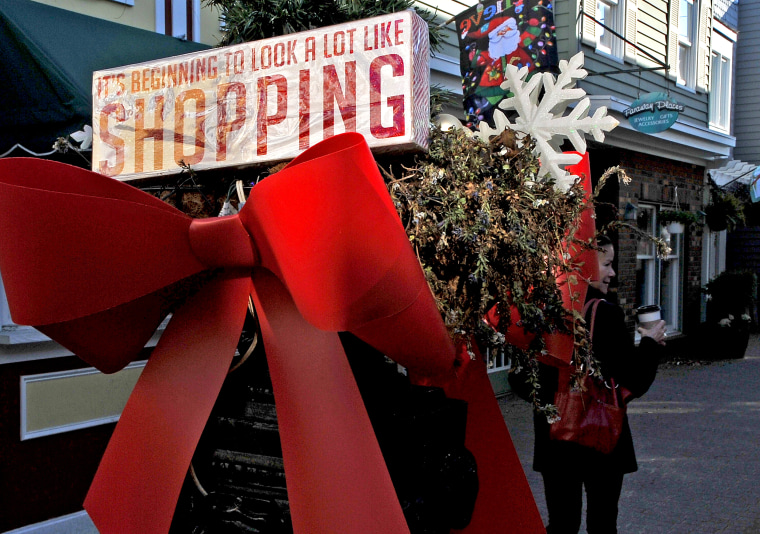‘Tis the season for holiday-themed and peppermint-flavored everything in the food and beverage industry. And it’s near impossible to go shopping now that Halloween has scurried off into the night without being aurally assaulted by Christmas carols and visually overwhelmed by arrays of red-and-green displays.
When will retailers realize that they’re killing us with their put-on yuletide cheer?
Not anytime soon, say those who closely follow the industry. The problem is we still respond when sellers drape themselves in holiday wrapping.
“It’s like going to your parents’ house when they put the holiday decorations up,” said Randy Lopez of Synergy Restaurant Consultants. “If people don’t feel like they’re in the holiday spirit, they’ll almost force themselves to be a part of it. The idea is, ‘This drink is going to make me feel more Christmas-y. I need something with a candy cane in it.’ You know, those core flavors and tastes.”
The past week has offered multiple examples of grand brand holiday announcements, a tradition that dates back at least to Macy’s creation of the Thanksgiving Day parade in 1924.
Starbucks, for example, proudly announced Monday that its “festive red holiday cups” were back, great news, it said, for those for whom “the holidays begin when they catch their first whiff of eggnog or have their first taste of peppermint.”
Not to be outdone, Dunkin’ Donuts on the same day released its new holiday lineup, which includes a peppermint mocha coffee, a new Snickerdoodle croissant donut, or “cronut,” and other delicacies, to use the term loosely.

The puffery wasn’t limited to those who traffic in caffeine and pastries.
Wal-Mart announced on Friday that it will unleash an army of Santa Clauses over two weekends in December to turn its 3,600 Supercenters into "holiday retailtainment" festivals that will feature Christmas carols, toy demonstrations, food tasting and more.
And do we really need a Jack in the Box’s holiday antenna ball? Or IHOP’s holiday hotcakes? Wouldn’t consumers appreciate a reprieve from the holiday madness they complain about, and reward the brave retailer willing to buck the seasonal tide?
Even some marketing arena acknowledge that the marketing blitz can backfire.
Related: You're Already Done With Your Holiday Shopping? How Aggravating!
“Retail brands often take a hit with negative consumer’s perceptions when they decorate for Christmas too soon,” acknowledged Linda Duke, CEO of Duke Marketing. “Restaurants typically do a good job introducing enticing menu items that bring in guests during the fall. However, this year there has been a plethora of pumpkin offerings, which could be seen as overkill. It’s called ‘copycat marketing’ and restaurateurs follow the leader when it comes to limited time menu offers.”
In the case of pumpkin-flavored drinks, the blame squarely rests with Starbucks. It introduced its pumpkin spice latte in 2003 in 100 restaurants, then rolled it out throughout the chain after discovering it had a hit on its hands. As “lead developer” — this happened in Seattle, remember — Peter Dukes recalls in Starbucks’ official history of the drink, the pumpkin spice latte went on to “become a harbinger of the season.”
The problem, Duke said, occurs when other companies piggyback on the trend, and introduce their own pumpkin-flavored beverages. Soon overkill occurs and consumers become fatigued and uninterested, she said.
There are a few signs of hope for those who could do with a few fewer “ho-ho-hos” this year.
Some restaurant chains buck the holiday trend altogether. The In-N-Out burger chain, for example, has a menu that stays the same throughout the entire year. No nutmeg flavored french fries, no eggnog shakes.
A handful of retailers are balking at opening on Thanksgiving this year, at least stalling the trend toward turkey-fueled stampedes for early deals, whether real or imagined. And while Black Friday remains the busiest shopping day of the year, retailer REI made headlines when it announced it would remain closed so its employees could enjoy the great outdoors.
Related: Macy's Throws Down Thanksgiving Gauntlet, Will Open at 6 p.m.
But while opting out may be a great marketing ploy in itself, Lopez said we shouldn’t expect it to lead other sellers and restaurants to stand down.
As Lopez explains it, the primary goal of companies is survival. They want to ensure consumers don’t forget about them during the busy holidays, so they try to bask in the glow of Christmas, the biggest shopping holiday of all.
“Obviously, anything you do that generates a press release is geared to drive traffic and just get some buzz about your brand, but it’s also about staying relevant,” he said. “I think they are two trains of thought. One is that you’re building sales for the holiday, making sure your numbers are up there, competing with last year. The other part is seeding next year’s sales, because you will see a drop. So a big part of holiday marketing is about driving traffic for January. It’s a preemptive strike.”
And that explains why Starbucks would issue an entire press release for red cups.
Creating a brand-specific holiday icon, like Coca Cola’s Santa can or Budweiser’s Clydesdales, is a marketing home run. When it works, that new offering becomes a tradition.
Coca-Cola, for example, first used Santa imagery in 1931. Not only does it persist to this day, there’s a whole market for Coca-Cola brand Santa collectibles, from ornaments to glasses.
“Companies have to figure out how they can help the customer connect with the brand and the holidays at the same time,” said Lopez. “And then the idea is to create a holiday offering that is brand specific.”
